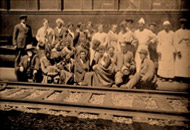On Friday, January 28, one of Sharon’s landmarks was reduced to a pile of rubble consisting of brick, mortar, and wood. But more than rubble, 100 years of memories of school days — good old happy school days — left the scene, making room for progress. As most everyone knows now, the town is getting a Dollar General on the old school site. We’re really coming into the 21st century.
Many were sad to see the early school disappear from the scene. After all, there were a lot of memories invented in the building. But such is the way of progress.
Before the Sharon School was built in 1911, the first school in the area was established in 1882 in a vacant log cabin near what is now the center of town, seven years before the town was chartered. The next appearance of a school was in the spring of 1888 when one on the Chesterville-Shelbyville Road (now Woodlawn Street) was started by John A. Byers. Woodlawn, as the school was called, was still in operation in 1892 when W. O. Sherer conducted classes for a summer term.
In a speech in 1925, Dr. Joseph H. Saye spoke of this school. “The first school building that was used in Sharon when I first came to York County some forty years ago,” said Saye, “was located about one half mile north of town on the Chester and Shelby Road. This house was a planked up affair about 14 by 15 feet with a rock and mud chimney. It possessed one door, a small window with a plank shutter and no glass. It was considered a good school house for that day.”
Shortly after the town was chartered in December 1889, a small, frame schoolhouse was constructed near the present center of the business district on York Street. Miss Jennie White, sister of Dr. W. G. White of Yorkville, was Sharon’s first schoolteacher in its first school. In 1891 a resident complained about the two-year-old grammar school that must have been rather shabby. “We have a first rate teacher,” he exclaimed, “but a very poor building.” Others had the same opinion because the following August a joint stock company was formed to raise funds for a new building on what is now Warmoth Avenue. In September, contracts were awarded to James Holland of Clover to build the school and to Robert B. Hartness to furnish rock for the foundation. By the middle of October, the site had been cleared and construction had begun. When construction was completed in 1894, the town rejoiced over its new, two-story, frame school building.
Professor Stanford and his family arrived in Sharon from Decatur, Georgia, before the end of January 1894. He was to head up the school that would open within a few months with 35 students. It which would soon grow to 50.
By 1910 the third school (the one razed in January) was under construction. It would continue to serve the town and surrounding communities for the next 50 years. The spacious, two-story brick building, was built on a small tract known as “the barn lot,” donated by W. L. Hill, where he had a barn and stabled horses.
The school opened for the 1911 fall term. Water was supplied to the school from a well on the Sherer place, which was located on the present-day north corner of York Street and Warmoth Avenue. The old frame school was purchased and dismantled by W. Press Youngblood, who built a house on his farm in the Blairsville community with the materials. That house was later purchased by Bruce Sherer. The building is presently undergoing some renovation.
The school was built to serve the town and area as both a grammar and a high school. Graduating classes in those early days were small. There were only three who graduated in 1914 — Elizabeth Allison, Ralph Cain, and John Rainey Saye. Girls who graduated from high school might go to Winthrop College to study for the teaching profession, but a second choice was offered when Mrs. J. A. Shannon began conducting secretarial courses in the Shannon Building. She taught typing, shorthand, bookkeeping, and stenography. Some of her early students were Mary Love, Margaret Gascoign, Mary Sherer, Eula Latham, and Mamie Burgess. In a couple of years, Mrs. Shannon extended her work by starting classes in York’s Bratton Building on Wednesday and Saturday afternoons. By 1928 Mrs. Shannon was teaching more than 100 students in the “Commercial Department” of the Yorkville School.
In 1920 the Sharon School Board hired J. W. Shealy, who had taught in the Clover schools for several years. This began a long career that would last for nearly 50 years. Mr. Shealy, or “Cap’n” as he was called, was well respected, but he could strike shuddering fear in a young boy.
The following year, on April 29, 1921, commencement exercises at the high school began on Friday evening before a packed auditorium with standing room at the doors and windows. Among the graduates were Paul Whisonant, Clarence Shillinglaw, Flay Plexico, Eunice Cain, Neil Horton, Aileen Shannon, and Annie Ramsey. The highlight of the exercises was a declaimer contest with 15 contestants vying for the first prize of a $5 gold piece. The contestants were Obie Robinson, Mary Latham, Thelma Pratt, Beulah Morris, Eunice Cain, Aileen Shannon, Sallie Scott Erwin, Mattie Mae Whitesides, Mary Whisonant, Neil Horton, Lee Youngblood, Paul Whisonant, Clarence Shillinglaw, John Faulkner Rainey, and Flay Plexico. The following Wednesday at the closing exercises, the judges announced the winner was Sally Scott Erwin. Second and third place were awarded to Paul Whisonant and Neil Horton.
Though schools had a compulsory attendance law to comply with, all teachers were familiar with the needs of agriculture and expected farm children to be absent or late at times. It was not unusual for students to be absent for roll call to hoe or pick cotton, pull corn, or put up hay. Girls were often out to help with the washing or the younger children.
As today, schools were wonderful incubators for childhood diseases — itch and lice were common afflictions, both of which were viewed as shameful. During an epidemic of itch in the 1920s, a local resident reported that “quite a number of pupils [are] getting considerably behind with their scratching.” Itch and lice carried such a stigma that parents sometimes created a conspiracy, instructing their children not to tell anyone they had the afflictions. During these epidemics, poor mothers and grandmothers turned to home remedies, searching the land for pokeberry root, while stores would have a run on lard and sulfur. (I had a classmate who went to her grave condemning a schoolmate for giving her lice.) Periodically, a county nurse would come by to immunize students for flu. Teachers lined up their students in the hall with their left arms exposed. Some would cry, but all were scared stiff. Once a year these nurses gave quasi-tests for hearing and eyesight.
The school superintendent of education, John E. Carroll, called a meeting of parents and concerned people in May 1922 about adding an 11th grade to the Sharon School. Since most colleges were requiring a higher course of study, it would be necessary to add an 11th grade if students wanted to enter college. The trustees of Sharon School District 20 agreed to add an the grade to the system beginning in the 1922-1923 school year. At the same time, the first five grades of the country schools of Blairsville and Hoodtown were consolidated with Sharon.
The addition of an extra grade and incoming students from the other schools placed pressure on the trustees to deal with the problems of space and faculty. When the schoolhouse was built in 1911, it was considered adequate to handle any future growth, but consolidation had not been considered. To create more space at a minimum of expense, the stage in the upstairs auditorium was torn out, and the room divided into two large classrooms. A small room across from the auditorium, which was used as a library, was also converted into a classroom.
Realizing this was only a Band-Aid application to the problem, the trustees needed to make a decision for long-term plans. In the beginning, the trustees were divided on what to do. Some thought an addition to the present building would be sufficient, while others thought that a new school for the higher grades would be a better approach. The trustees studied the situation and found that it was cheaper to build a new building rather than build an addition. But the new building depended on the availability of state funds.
Sharon School Memories – Part II
J.L. West – Author
This article and many others found on the pages of Roots and Recall, were written by author J.L. West, for the YC Magazine and have been reprinted on R&R, with full permission – not for distribution or reprint!
Please enjoy this structure and all those listed in Roots and Recall. But remember each is private property. So view them from a distance or from a public area such as the sidewalk or public road.
Do you have information to share and preserve? Family, school, church, or other older photos and stories are welcome. Send them digitally through the “Share Your Story” link, so they too might be posted on Roots and Recall.
Thanks!
User comments always welcome - please post at the bottom of this page.



Share Your Comments & Feedback: